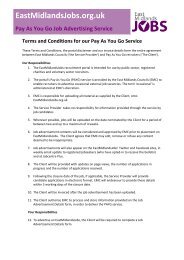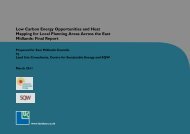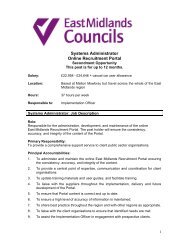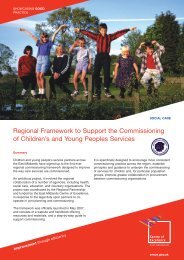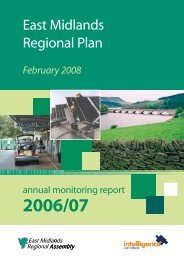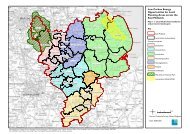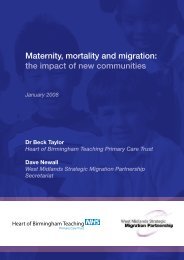East Midlands Regional Spatial Strategy 2005/06
East Midlands Regional Spatial Strategy 2005/06
East Midlands Regional Spatial Strategy 2005/06
You also want an ePaper? Increase the reach of your titles
YUMPU automatically turns print PDFs into web optimized ePapers that Google loves.
Data Analysis<br />
4.62 The paucity of information on retailing and<br />
leisure contained in the local authority monitoring<br />
questionnaires was a problem identified in the<br />
previous AMR. It is pleasing to note that an increased<br />
number of authorities have been able to supply<br />
some information on this issue this year and this is<br />
presented in Tables 4.20 and 4.21. Despite this, the<br />
information from the questionnaires remains partial<br />
with many local authorities being unable to provide<br />
any data making meaningful analysis difficult.<br />
4.63 It has only been possible to once again use the<br />
information provided in the 2004/05 monitoring<br />
report referring to the 2002 IGGI data that looked at<br />
the distribution of land in town centres. It has not<br />
been possible to analyse the change in the<br />
distribution of town centre land.<br />
Policy Commentary<br />
4.64 Despite some progress since the last AMR, the<br />
paucity of information about retail and leisure<br />
developments in the <strong>East</strong> <strong>Midlands</strong> continues to<br />
hamper a realistic assessment of the success of this<br />
policy and the extent to which the requirements of<br />
the sequential test for the location of such facilities<br />
have been satisfied.<br />
4.65 Those authorities that have not already done so<br />
are again urged to put in place systems and practices<br />
to ensure that the sequential location of proposed<br />
and developed retail and leisure facilities can be<br />
reported upon more accurately in future AMRs.<br />
4.66 From the limited available data on the location<br />
of retail developments supplied by the local<br />
authorities, 74% of commitments and 84% of<br />
developments completed or under construction<br />
were located within city, town, district and local<br />
centres thereby promoting their vitality and viability<br />
as advocated by the policy.<br />
4.67 The proposed expansion of Nottingham’s<br />
Broadmarsh Centre is a prime example of city centre<br />
retail development, while Derby’s Eagle Centre<br />
extension will provide an additional 48,000 square<br />
metres of floorspace. Both schemes will significantly<br />
enhance city centre retail vitality and viability while<br />
permission also exists for the redevelopment of<br />
Derby’s bus station into a major leisure destination. In<br />
addition, Derby Cityscape, Derby’s Urban<br />
Regeneration Company, continues to work to bring<br />
forward schemes, such as the ‘Friar Gate Studios’<br />
creative industries development.<br />
4.68 An example of a retail development to improve<br />
the vitality and viability of a district centre is the<br />
long-awaited start of construction work in Matlock in<br />
Derbyshire which will provide housing and a town<br />
centre relief road as well as a new supermarket.<br />
4.69 In Northamptonshire there is a recognised<br />
need to improve the retail offer of the county and<br />
reduce leakage.There is a strong policy push for<br />
Northampton to become a regional centre in its own<br />
right, as part of MKSM growth plans.<br />
4.70 Leicestershire County Council, through the<br />
Leicestershire Rural Partnership, provides grants for<br />
retailers under the Living and Working Over the Shop<br />
grant scheme as part of the Market Towns Initiative.<br />
The Market Towns Initiative also provides a<br />
comprehensive development programme to<br />
promote the economic wellbeing of market towns<br />
and rural centres.<br />
Policy 24: <strong>Regional</strong> Priorities for Rural<br />
Diversification<br />
Local authorities and Sub-<strong>Regional</strong> Strategic<br />
Partnerships should work together to promote<br />
the continued diversification and further<br />
development of the rural economy<br />
Target: Increase in new business start ups and new<br />
jobs<br />
Indicators:<br />
• Number of new business start ups<br />
• New jobs created<br />
<strong>East</strong> <strong>Midlands</strong> <strong>Regional</strong> <strong>Spatial</strong> <strong>Strategy</strong> Annual Monitoring Report <strong>2005</strong>/<strong>06</strong><br />
63




